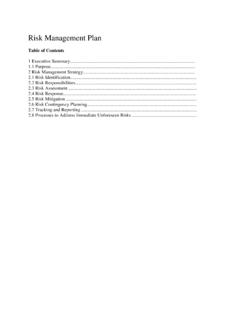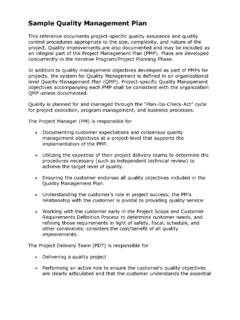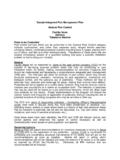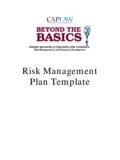Transcription of Sample Integrated Pest Management Plan Rodent …
1 Sample Integrated Pest Management plan Rodent Control Facility Name Address Telephone Number Rodents to be Controlled For the purposes of this program, Rodent control refers to commensal rodents such as the Norway rat, Roof rat, House mouse, Deer mouse and White Footed mouse. Squirrels, Chipmunks, Woodchucks, Muskrats and other non-commensal rodents and similar species are specifically excluded. General Facility Name will be inspected by name of the pest control company (PCO) for the purpose of identifying potential problem areas that may be contributing to Rodent infestation within the facility, making recommendations for corrective measures that should be implemented and developing a comprehensive Integrated pest Management (IPM) plan . The IPM plan will utilize all methods of Rodent control which may include structural maintenance, sanitation, monitoring for Rodent populations, mechanical and biological control and the judicious use of pesticides.
2 These methods will help to eliminate food, moisture and harborage for rodents, making their survival more difficult. Pesticides will not be applied on a routine basis, however, they may be used as a tool to maintain Rodent populations at or below an acceptable level. The selection of pesticides that may be used will be based on a pre-determined hierarchy which will utilize least toxic products as first choice. Proper implementation of this program will reduce the volume, toxicity and frequency of pesticide applications, thereby reducing the risk of potential exposure of building occupants who may be sensitive to their use. The PCO and name of responsible individual - Contracting Officer's Representative (COR) shall meet to discuss areas that have been problematic or sensitive. ( , operating rooms, prisons or areas where there is a history of high pest pressure) Areas that are sensitive to pesticide use will also be discussed.
3 ( , daycare areas, elderly residence, work area of sensitive employees, etc.) Once these areas have been identified, the PCO and COR will discuss various Rodent control options and determine the speed of control necessary as well as threshold/action levels based on population and species. Recommendations Name of PCO will submit recommendations for corrective measures in writing to Name of (COR) prior to the application of any pesticides. He/she is responsible for scheduling and coordinating structural maintenance of the facility and will act on the recommendations as soon as possible. He/she will report in writing which recommendations will not be followed and state the reasons if no action is to be taken as required by RCSA (c). Otherwise, all IPM methods that are recommended will be followed.
4 Pest control services will be supervised by name & certification number, and performed by name & certification number(s) of name of pest control company & business registration number. The IPM program will begin on date with six weekly visits in order to start the program. Subsequent service calls will be performed twice a month or as needed depending upon pest pressure. Service calls will be scheduled on Day of week & approx. time and will include a visual inspection of potential problem areas and all monitoring devices, application of pesticides where pest populations exceed their threshold level. Records will be completed at the conclusion of each service call and will include written recommendations of corrective measures that need to be made by building maintenance personnel. A member of the custodial staff should be available to allow the pest control technician to access areas that may be locked.
5 Records The pest control technician will indicate pest problem areas and provide written recommendations for structural, sanitary or procedural modifications on "Pest Control Service Record and Pest Inspection Report" forms or substantially similar substitute. These forms will be kept in a file that will be maintained in responsible individual(COR) office. He/she will act as a liaison between the pest control company and department supervisor(s) and will be responsible for notifying the appropriate personnel of corrective actions that are needed ( , sanitation). Pest sighting report logs provided by name of PCO will be reviewed by the pest control technician at the beginning of each service call. The log will be maintained in responsible individual (COR) office and will serve as a tool to facilitate communication between all personnel and the pest control technician.
6 All Rodent sightings should be reported in the logs and should include specific information as to the location and type of Rodent , if known. Whenever possible, a Sample (animal or fecal) will be provided to the pest control technician for identification purposes. Monitoring Service call/monitoring inspections will be limited to list specific areas that will be inspected - ( , kitchen, kitchen storage, dish room, laundry room, cafeteria, employee lounge, custodial closets, locker rooms, laundry room, main office, hallways on ground and main floors, boiler room) and the perimeter of the building unless activity or sightings in other areas have been reported in the pest sighting log. Non-toxic glue boards and non-toxic bait blocks placed in tamper proof bait stations will be used for the duration of the IPM program to monitor Rodent populations and activity within the facility.
7 Non-toxic tracking powder may also be utilized as a monitoring tool. They will be placed in areas where Rodent activity has been identified or is likely to occur. The dates of installation and servicing will be indicated on each monitor and the pest control technician will create diagrams or maps indicating their placement. The diagrams will be maintained as part of the pest control companies service record. Visual inspections of the glueboards and bait stations will help the pest control technician to identify specific areas of infestation, if any, and assess the need for further action. The glueboards and bait stations will be placed as follows; List specific areas - ( , Kitchen & Dish Room - 20 glueboards + 2 bait stations, Kitchen Storage - 8 glueboards + 2 bait stations, Laundry Room - 2 glueboards, Cafeteria - 1 glueboard (Under the vending machine), Employee Lounge - 4 glueboards, Mens Locker Room - 2 glueboards, Womens Locker Room - 2 glueboards, Laundry - 2 glueboards, Custodial Closets - 2 glueboards, Main Office - 6 glueboards and Boiler Room - 8 glueboards + 2 bait stations.)
8 Rodents In addition to structural damage, mice and rats are known to spread organisms such as Salmonella bacteria, eggs of the tapeworm, Hantavirus and Leptospirosis, to name a few. They reproduce an average of 4-8 times per year. They can reproduce more often when conditions are favorable. Litters average 4-12 young. Rodents, particularly Deer Mice, will hoard food. This is an important fact to consider if baits will be utilized for their control. Pelleted, seed or loose meal bait will only be used for outdoor applications and placed in a manner to limit the risk of exposure to unprotected persons and non-target animals. Bait blocks will be anchored properly to prevent mice from carrying bait off to another location. Norway Rats Norway rats are much larger than mice, usually brown with scattered black. Their tails are shorter than the head and body.
9 They will build a nest of soft materials in and around lower floors of buildings and foundations in burrows, crawlspaces and underneath/behind stationary objects. Rats will range an average of 100-175 feet from their nesting area. They may range farther if food is limited. They are omnivorous, preferring food with a high carbohydrate and protein content. They need water on a daily basis in order to survive. Norway rats will prey upon mice, therefore, they are usually not found living in the same area of a building. House Mice House mice are small, light brown to light gray in color with smooth fur. Their tails are longer than their head and body. Mice will nest in walls, ceiling voids, cabinets, drawers, appliances, furniture They usually nest close by to their food source, with an average range of 10-35 feet.
10 They do not need water on a daily basis. House mice are omnivorous, however, they prefer seeds and grains. Deer Mice Deer mice, known vectors of hantavirus, will also enter houses, garages and other structures particularly as cold weather approaches. They are a reddish brown with a white chest and white feet. Their nests are usually underground, however, they will construct nests above ground in areas similar to the House mouse. Deer mice normally breed during spring and fall, however, they will breed more frequently under favorable conditions. They prefer to feed on nuts, seeds, berries and insects. Hantavirus Building maintenance and custodial staff should always take appropriate precautions to protect themselves against hantavirus. Documented cases of hantavirus have occurred mostly in the Southwestern United States, however, two cases have been documented in the Northeast, one in New York and one in Rhode Island.
















